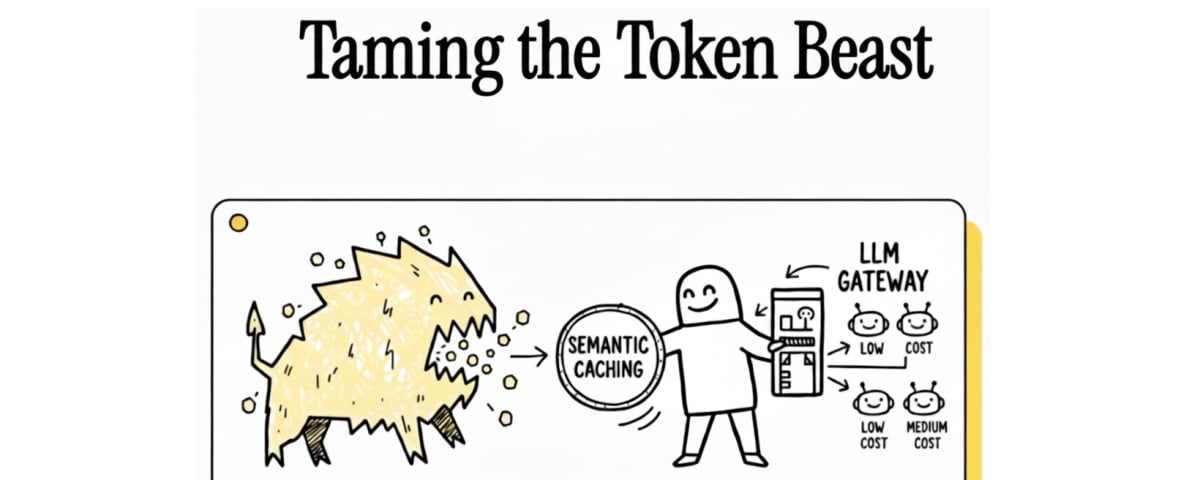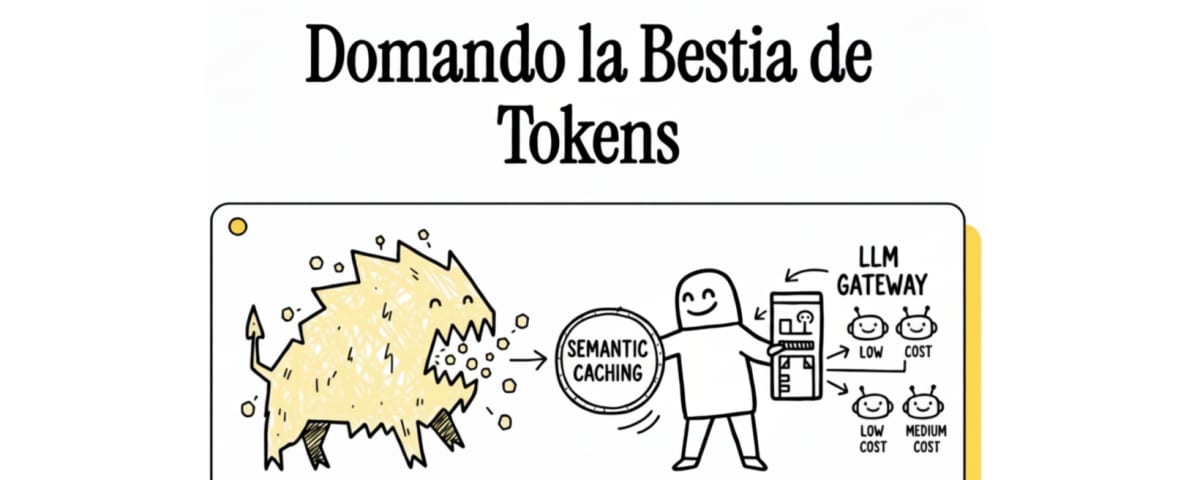Introduction
Tired of seeing your API bill (OpenAI, Anthropic, Google) skyrocket every time a user asks a slightly different question? Does the latency of your RAG application bother you because you're asking the LLM the same idea over and over again?
In your AI projects, every API call is money and time.
What if I told you that you can save up to 90% of those costs and drastically reduce latency with just one line of configuration?
It's called Semantic Cache, and we're going to implement it simply with Redis and LangChain.
What is semantic cache?
A semantic cache is not the typical (key, value) cache where key must be an exact match. It's much smarter.
When you make a prompt, the cache first generates an embedding (a vector representation) of your question and searches its database if there's already an answer for a semantically similar question.
Prompt 1: "What foods are known in Madrid?"
Prompt 2: "What do people usually eat in the capital of Spain?"
A normal cache would fail because they're not identical. A semantic cache understands that they mean the same thing and returns the cached response for Prompt 2, avoiding the API call.
This is easy to implement using major LLM frameworks such as LangChain and being able to use any vector database for it.
Advantages (Why use it?)
-
Brutal Cost Reduction: If 50% of your users' queries are conceptually similar ("what's the weather in BCN?" vs "what's the weather like in Barcelona?"), you're paying twice for the same answer. Semantic cache intercepts this. Savings of 50-90% are realistic in production applications.
-
Near-Zero Latency: A call to
gpt-4can take 3 to 10 seconds. A vector search in a local or hosted Redis takes milliseconds. For your users, the difference between a slow app and an instant one is retention. -
Response Consistency: Has the LLM ever given you a perfect answer and then, with a similar prompt, hallucinated or gave a different format? Semantic cache ensures that once you have a "golden answer" for a concept, that's the answer you serve. You control the quality of repeated responses.
-
Trivial Implementation (with LangChain): As we'll see later, this is not a month-long project. It's literally one line to activate the cache in your LangChain LLM object.
Cons (The Disadvantages)
Let's be transparent, not all use cases are suitable for using this type of cache. Everything will depend on whether a small change should change your response (as can be some RAGs) or if it's always the same response as in the cases of frequently asked questions in customer support.
- Embedding Cost: The cache is not 100% free. Each input prompt must be vectorized to perform the similarity search. This has a cost (small, but not zero) and latency (very low, but not zero).
- Cache Invalidation: This is the classic problem in computer science. If the "correct" answer to a question changes (e.g. "What offers are available in the store?"), your semantic cache will serve the old answer (Christmas, summer, black friday...) until you manually invalidate it.
- Threshold Adjustment: You'll have to decide what is "similar enough". A very low threshold won't cache almost anything; a very high threshold could give incorrect answers to questions that are subtly different.
- Infrastructure Requirements: You need a Redis instance that supports vector search (like Redis Stack or Redis Cloud). It doesn't work with the basic version of Redis.
Comparison with other systems
How does this compare to basic cache or having nothing?
| Feature | No Cache (Default) | Exact Cache (e.g. InMemoryCache) | Semantic Cache (Redis) |
|---|---|---|---|
| API Cost | Very High | Medium-High | Very Low |
| Latency | High | Low (if exact match) | Very Low |
| Flexibility | N/A | Very Low (only exact match) | High (match by meaning) |
| Handles Accents/Errors? | N/A | No | Yes |
| "Hello" vs "Hi"? | N/A | Fails (Miss) | Succeeds (Hit) |
The Exact Cache (like InMemoryCache or simple RedisCache from LangChain) is better than nothing, but fails as soon as the user adds a period, an emoji, or changes a word. No cache is burning money in production.
Keep in mind that you can also use prompt caching to save costs, you can see how to use it in this post
Implementation
1. Installation
You'll need the LangChain libraries, an embeddings model (we'll use Gemini's) and the Redis client.
To install the dependencies we're going to use UV. If you want to know how to use it, you can read this post about UV.
# Install dependencies
uv pip install langchain langchain-openai redis
# Make sure you have a Redis Stack server running
# The easiest way is with Docker:
docker run -d -p 6379:6379 -p 8001:8001 redis/redis-stack:latestNote: We use redis/redis-stack because it includes the RediSearch module needed for vectors
2. Semantic cache configuration
import time
from langchain.globals import set_llm_cache
from langchain_redis import RedisSemanticCache
from langchain_google_genai import ChatGoogleGenerativeAI
from langchain_google_genai import GoogleGenerativeAIEmbeddings
embeddings_model = GoogleGenerativeAIEmbeddings(model="models/gemini-embedding-001")
REDIS_URL = "redis://localhost:6379"
semantic_cache = RedisSemanticCache(
redis_url=REDIS_URL,
embeddings=embeddings_model,
distance_threshold=0.01
)
llm = ChatGoogleGenerativeAI(
model="gemini-2.5-flash",
temperature=0,
max_tokens=500,
timeout=None,
max_retries=2
)
set_llm_cache(semantic_cache)Now let's test it:
# Function to test semantic cache
def test_semantic_cache(prompt):
start_time = time.time()
result = llm.invoke(prompt)
end_time = time.time()
return result, end_time - start_time
# Original query
original_prompt = "What is the population like in the capital of Germany?"
result1, time1 = test_semantic_cache(original_prompt)
print(
f"Original query:\nPrompt: {original_prompt}\nResult: {result1}\nTime: {time1:.2f} seconds\n"
)
# Semantically similar query
similar_prompt = "What is the population like in Berlin?"
result2, time2 = test_semantic_cache(similar_prompt)
print(
f"Similar query:\nPrompt: {similar_prompt}\nResult: {result2}\nTime: {time2:.2f} seconds\n"
)
print(f"Speed improvement: {time1 / time2:.2f}x faster")3. Results
These are the results:
Original query:
Prompt: What is the population like in the capital of Germany?
Result: content='The population of Berlin, the capital of Germany, is **diverse, dynamic and constantly evolving**...
Time: 13.93 seconds
Similar query:
Prompt: What is the population like in Berlin?
Result: content='The population of Berlin, the capital of Germany, is **diverse, dynamic and constantly evolving**...
Time: 0.31 seconds
Speed improvement: 44.45x fasterAs you can see, it's not only much faster but we just saved over 4000 tokens of output + reasoning
Common Errors
-
The problem: I get a Redis connection error (
redis.exceptions.ConnectionError).- The error:
Connection refusedorTimeout. - The solution: Make sure your Redis server is running and accessible at the URL you passed (
redis://localhost:6379by default). If you use Docker, verify that the port-p 6379:6379is mapped.
- The error:
-
The problem: My cache doesn't work, it always calls the API.
- The error: There's no error, but the cache always fails (always miss).
- The solution: Your
score_threshold/distance_thresholdis probably too strict. Embeddings are rarely 100% semantically identical. Try lowering the threshold to0.9or0.85for testing and adjust from there.
-
The problem: I receive a
redis.exceptions.ResponseError: unknown command 'FT.SEARCH'error.- The error: The Redis server doesn't understand vector search commands.
- The solution: You're not using Redis Stack. Semantic cache requires the RediSearch module (which includes vector search). It won't work with the standard
redis:latestDocker image. Make sure to useredis/redis-stack:latest.
Conclusion
Semantic cache is not a "nice-to-have"; it's an absolute necessity for any production LLM application.
It's the difference between an app that is expensive and slow, and one that is cheap and instant.
As a developer and as a user, your time and computing resources are the most valuable. Letting an LLM answer the same question (worded in 10 different ways) is a waste of both.
Try it in your next project and start seeing the benefits.



